Futaoki: Take Fushi
In Chanoyu, hot water for tea, ma-tcha, 抹茶, powdered-tea, is traditionally made with water heated in a kama, 釜, kettle, placed over a sumi-bi, 炭火, charcoal-fire, in a hearth: the hearth maybe a portable fu-ro, 風炉, wind-hearth, of in a sunken ro, 炉, hearth. Because the kama has no handle or spout, the lid must be removed to gain access to the hot water, yu, 湯. A support is needed for the kama no futa, 窯の蓋, kettle’s lid – a futa-oki, 蓋置, lid-place.

Ao-dake futa-oki, 青竹蓋置, green-bamboo lid-place, moto-bushi, 元節, origin-node, used with the fu-ro, 風炉, wind-hearth, supporting a kama no futa, 窯の蓋, kettle’s lid, with a tsumami, 摘み, pinch (knob) in the form of a five-petal ume no hana, 梅の花, ‘prunus’ flower.
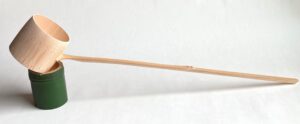
Hi-shaku, 柄杓, handle-ladle, resting on an ao-dake futa-oki, 青竹蓋置, green-bamboo lid-place, for use with fu-ro, 風炉, wind-hearth.
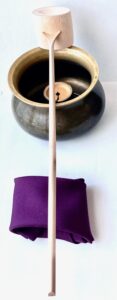
The futaoki is primarily used to support the kama no futa, 釜の蓋, kettle’s lid, as its name indicates, however, there are many Tea presentations during which the hishaku is temporarily rested on the futaoki. This is true for presentations of koi-cha, 濃茶, thick-tea, and usu-cha, 薄茶, thin-tea.
In many koicha Tea presentations, the futaoki is taken from the ken-sui, 建水, build-water, placed in its proper location, the hishaku is rested on the futaoki, and everyone bows in unison to begin the presentation.
Some koicha Tea presentations begin prior to the futaoki being taken from the kensui, and later the futaoki is placed in its proper location, and this is when everyone bows in unison.
The futaoki is often brought into he room resting inside the kensui along with the hishaku resting on top of the kensui.
In some Tea presentations the futaoki is resting inside the kensui and both are arranged in the room prior to the entrance of the host.
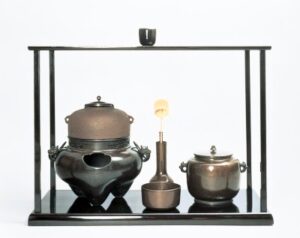
Shin dai-su, 真台子, true support-of, black-lacquered display stand with fu-ro, 風炉, wind-hearth, and kai-gu, 皆具, all-tools, Kara-kane, 唐銅, Tang-copper, bronze.
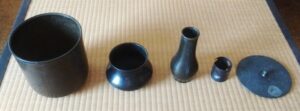
Kai-gu, 皆具, all-tools, Kara-kane, 唐銅, Tang-copper, bronze. Utensils from left:
Mizusashi, 水指, water-indicate
Ken-sui, 建水, build-water
Shaku-tate, 杓立, ladle-stand
Futa-oki, 蓋置, lid-place
Futa (mizusashi), 蓋, lid
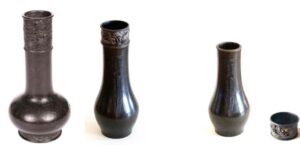
From left: bronze vase with bulbous body and tall neck and raised foot, with ornate decorative frieze wave pattern around the neck, Song-Yuan, dynasty, China; h. 6 sun kujira-jaku.
Bronze shaku-tate, 杓立, ladle-stand, with a design of three pointed lappets; h. 4.6 sun kujira-jaku, Japan. Shown with a bronze ring with relief design of a dragon sitting on top of the shakutate, the metal ‘napkin’ ring is a China export; h. .8 sun kujira-jaku. Full height. 5.4 sun kujira-jaku. Some scholars identify the lappet designs as bamboo leaves.
Bronze shaku-tate, 杓立, ladle-stand, with a design of three pointed lappets; h. 4.6 sun kujira-jaku, Japan.
Bronze ring with relief design of a dragon, China export; h. .8 sun kujira-jaku.
As a grouping, the origin of the futaoki form may be associated with the shakutate, as can be seen in the above image with the bronze futaoki resting on top of the shakutate.
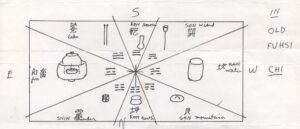
Diagram of the ji-ita, 地板, earth-board, of the dai-su, 台子, support-of, showing the identification of the Tea utensils and the trigrams of the ha-kke, 八卦, eight-signs, of the Eki-kyō, 易経, Change-sutra. The futaoki is identified with the trigram, ☳, Shin, 震, Tremble, symbolic of lightning. The jiita arrangement of the hakke is the ‘old’ arrangement created by Fuhsi, whereas the ten-ita, 天板, heaven-board, arrangement is the ‘new’ iteration of the hakke created by Prince Wen.
When not in use, the futaoki is held in the ken-sui, 建水, build-water, which is identified with the trigram, ☷, Kon, 坤, Earth. In the I Ching, Ekikyō, Thunder and Earth combine to create the hexagram 24, Fuku, 復, Return, again. This hexagram signifies a new beginning, a return to a positive state after a period of difficulty or stagnation.
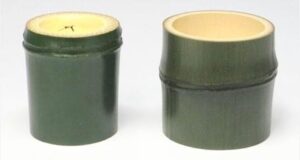
The height of Rikyū’s take futa-oki, 竹蓋置, bamboo lid-rest, measures 1.8 sun kane-jaku, 1.8 寸曲尺, ‘inch’ bend-span: also 18 bu (分) kane-jaku, 180 rin (厘) kane-jaku. The 1.8 sun kane-jaku measurement equals 1.44 sun kujira-jaku. Ideally, the bamboo lidrest is made of freshly cut green bamboo: ao-dake, 青竹, green-bamboo, hiki-kiri, 引切, draw-cut (sawn).
Some may question why the height of the futaoki measurement of 1.8 sun kane-jaku. 18 is also three sixes, and may relate specifically to the Buddhist, Taoist, and Tantric concept of Jū-hha-kai, 十八界, Ten-eight-realms: the existence and functions of the six human sense organs, sense objects, and consciousnesses.
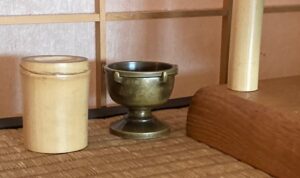
Take futa-oki moto-bushi, 竹蓋置元節, bamboo lid-place origin-node, 1.8, sun kane-jaku ho-ya gō-ro futa-oki, 火舎香炉蓋置, fire-house incense-hearth lid-place, with inverted lid; h. 1.5 sun kane-jaku. The thickness of the take daisu jiita 1 sun kujira-jaku or 1.25 sun kane-jaku. The height of the take futaoki of Takeno Jō-ō, 武野紹鴎, War-field Assist-gull, was 1.5 sun kane-jaku.
The number 18 in its various manifestations is a very auspicious number in Japanese arts and science. The number 18 is symbolic of life. The Kanji for the number 18 is written jū–hachi, 十八, 10 8, ten-eight. These two Kanji may be written together to form the Kanji for ki and moku, 木, tree, wood, etc. The Kanji, 木, also means a living thing.
The size of Rikyū’s take futaoki at 1.8 sun kane–jaku is emblematic and symbolic of life itself. Made of freshly-cut green bamboo, ao-dake, 青竹, the futa-oki is relatively still alive. Rikyū’s ao-dake hiki-kiri futa-oki is essential to the wabi nature of Chanoyu. The word wabi, 侘, means proud and lonely. In esthetics, wabi is the feeling observed when comparing the differences between new, refined, and aged, worn, irregular. Wabi is the contrast between two or more Tea utensils. For example, the contrast between a treasured tea container that is three hundred years old paired together with a freshly-cut green bamboo lid-rest.
The futaoki is cut from bamboo so that the fushi is close to the root end. This means that when used, the lidrest is upside down relative to the direction the bamboo grows. The fushi shows that the bamboo is inverted. The bamboo futa-oki is also a rest for the bamboo hi-shaku, 柄杓, handle-ladle, used to dispense hot and cold water when making Tea. The cup of the ladle has the root end at the bottom of the cup so that the cup is as the bamboo grows, the futaoki is reversed so that the two pieces are opposite, complementary to each other – In and Yō, Yin and Yang. The cup holds water, the bamboo lid-rest has a hole in the fushi, 節, septum, so that it cannot hold water, and is therefore Yō. There may be wordplay with fushi, which in Buddhism means death-less, fu-shi, 不死.
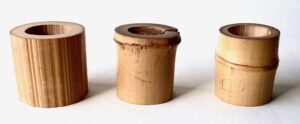
There are three types of bamboo futaoki – one for use with the furo and one for the ro, and one for both furo and ro. That for the furo has the fushi near the top of the futaoki, and is called ten-bushi, 天節, heaven-node, also called moto-bushi, 元節, origin-node. The futaoki for ro has the fushi near the middle of the bamboo, and is called naka-bushi, 中節, middle-node. One futaoki that can be used with both furo and ro is the fushi-nashi, 節無し, node-nothing, that is a simple cylinder without the node, and is called a wa, 輪, circle, and fuki–nuki, 吹抜, blow-through. The cylinder is the ‘true’ futaoki, that originated with the kai-gu, 皆具, all-tools, of the formal display stand, dai-su, 台子, support-of.
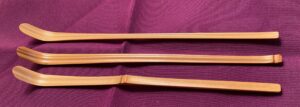
Three types of bamboo cha-shaku, 茶杓, tea-scoop, from top: fushi-nashi, 節無, node-nothing, or moto-bushi, 元節, origin-node; naka-bushi, 仲節, middle-node.
There are essential counterparts to the three types of futaoki in three types of cha-shaku, 茶杓, tea-scoop, and have the same names: moto-bushi, naka-bushi, and fushi-nashi. These three chashaku are identified as shin, 真, true, formal; gyō, 行, transitional, semi-formal, and sō, 草, grass, informal. There is a temptation to equate shin, gyō, and sō of the chashaku to the three types of bamboo futaoki, although authorities say there is none.

The three types of bamboo futaoki (L. 1.8 sun kane-jaku) compared to the three types of bamboo chashaku, and approximately the ideal length of 6 sun kane-jaku. The difference between 1.8 times three equals 5.4, finds consolation with the bend the scoop of the chashaku. Comparing also the alignment of the locations of the fushi in the chashaku parallel to the fushi of the three futaoki.
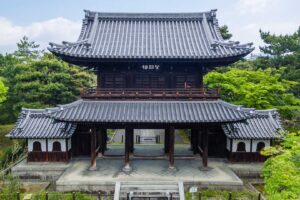
With some imagination, the three kinds of futaoki may be associated with the openings of the three gates of Buddhism. The san-mon, 三門, three-gates, are Ku-mon, 空門, Void-gate, Mu-sō-mon, 無相門, No-form-gate, Mu-gan-mon, 無願門, No-desire-gate, leads to Satori, 悟り, Enlightenment.

The shō-men, 正面, true-face, of a futaoki is determined primarily by the position of the fushi. Because of the nature of bamboo, the fushi is often irregular around the circumference. The shōmen is where the fushi is at its lowest level. Perhaps the most obvious is with the nakabushi. The lowest level of the fushi is where the measurement is established. The distance between the fushi and the bottom of the futaoki should be one sun kane-jaku, so that the distance between the fushi and the top of the futaoki is 8 bu kane-jaku. The measurements themselves manifest the very nature of the relationship between 8 and 10. The shōmen of the futaoki are an 8:10 ratio. For furo futaoki the ratio is in kane-jaku and for the ro futaoki the ratio is in kujira-jaku.
The location of the fushi on the tenbushi futaoki presents an unexpected relationship of measurements. Again, the height of the futa-oki is 1.8 sun kane-jaku. This kane-jaku measurement transposed to kujira-jaku is 1.44 sun kujira-jaku. The distance between the fushi and bottom of the futaoki is 1.44 sun kane-jaku. Should the bamboo crack and split, the open split becomes the shōmen. The rule for the location of a seam, to-jime, 綴じ目, bind-eye, is in the expression, ‘maru-mae kaku-muko’, 丸前角向, round-front cornered-beyond.
The significance of the five-point hole in the fushi of the futa-oki, may have deeper associations. The single hole drilled in the center of the septum of the futaoki prevents the bamboo from containing water, and is In, and at the same time the hole makes the futaoki itself Yō. But why are there also five tiny cuts around the small hole? One aspect of the kama, 釜, kettle, may point to a that relationship with the five-point hole in the futaoki. The ancient kama had a lid that had a tsumami, 摘み, pinch, knob, in the form of a hollow sphere, tama, 玉, created by two flowers and an escutcheon, za, 座, seat, with five-petals each. The ume tsumami may evoke the hō-ju, 宝珠, treasure-jewel, sacred to many Asian beliefs.

The flower appears to be ume, 梅, Japanese apricot, prunus. An additional flower is a kind of escutcheon, za, 座, seat, for the post of the knob attached to the lid. Thus, there are three ume flowers that form the knob that may have their own symbolism. The aspect that may most closely inform the five points of the bamboo futaoki is the five petals of the ume flower found on many kama lids. It is interesting to note that the ume flower has five petals, just as the hand has five fingers.
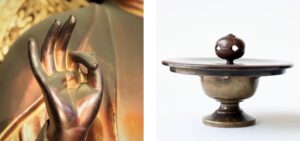
Hand of Amida in mudra called Rai-gō-in, 来迎印, Become-welcome, with the inner side of the thumb alongside the forefinger right hand. This is the correct way to grasp the knob of the kama. The hand gesture is directing the way to Amida’s western paradise Goku Raku Jō-do, 極楽浄土, Extreme-pleasure Pure-land.
Kama no futa, 釜の蓋, kettle’s-lid,showing ume tsumami, 梅摘み, pinch, bronze, supported on ho-ya gō-ro futa-oki, 火舎香炉蓋置, Fire-house incense-gater lid-place.
According to Urasenke tradition, the ume no hana tsumami knob of the kama no futa is grasped between the right thumb and side of the forefinger. Pinched like a person pinches their nose. The Japanese word for nose is hana, 鼻, a fine coincidental wordplay on hana, 花, flower.

From left: ho-ya gō-ro, 火舎香炉, fire-house incense-hearth, hoya shown with underside of lid removed, take naka-bushi futa-oki, 竹中節蓋置, bamboo middle-node lid-place.
Hexagram, ䷫, Kō, 姤, 44, Coupling. Other variations include coming to meet, and meeting. Its inner (lower) trigram is ☴ (巽 Son) ground = (風) wind, and its outer (upper) trigram is ☰ (乾 Ken) force = (天) heaven.
One of the objects Rikyū chose to use as a futaoki is the Buddhist altar ho-ya gō-ro, 火舎香炉, fire-house incense-hearth. One variety has a hemispherical lid with five holes and the base with five tsume, 爪, talons. Five talon dragons are emblematic of the emperor of China.
There may be wordplay with ume, the flower, and ume, 埋, cover, which is the role of a lid. Another more poetic connection between the bamboo futaoki and the ume of the kama lid knob in linking with the familiar auspicious phrase of shō-chiku-bai, 松竹梅, pine-bamboo-‘plum’. The source is the sound of the simmering water in the kama identified as matsu-kaze, 松風, pine-wind, the three friends of renewal.
Certain kinds of pine trees, such as Shiro-matsu, 白松, white-pine, have clusters of five needles, and are called go-yō–matsu, 五葉松, five-leaves pine. Because of the number of needles, such trees are regarded as auspicious.
The hollow chamber of bamboo is called a kan, 稈, which applies to all hollow stems of plants.

Naka-bushi cha-shaku, 仲節茶杓, middle-node, 6 sun kane-jaku, by Nishi-kawa Bai-gen, 西川楳玄, West-river Prunus-mystery, Taka-ga-mine, 鷹ヶ峰, Hawk ’s Peak, Kyō-to, 京都, Capital-city. Showing the scar where the branch bud was removed.
The bud of the stem on the bamboo stalk that is located at the fushi is called a kuki no me, 茎の芽, stem’s bud. At times, this bud may be included in the futaoki, chasen, and other bamboo objects. The same may be identified with indentation groove on the bamboo stalk where a branch would grow is called the hi, 樋, trough. This groove is an important aspect with regards to the chashaku. There is only one hi at a fushi, and they are on alternate sides of the stalk.
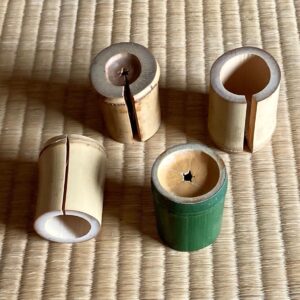
Group of moto-bushi, 元節, origin-node, take futa-oki, 竹蓋置, bamboo lid-place. Each has split due to shrinkage and age. The shō-men, 正面, true-face, of a take futaoki is located where the fushi is at its lowest level. Should the bamboo split, the split becomes shōmen.
The height of the futaoki established as 1.8 sun kane-jaku is critical for the take futaoki. Bamboo is a natural container, but because the futaoki has a hole in its septum, it is unable to contain water.
In traditional Japan, measurements were made with two different shaku: kane-jaku, 曲尺, bend-span, and kujira-jaku, approximately 30.3 cm, and kujira-jaku, 鯨尺, whale-span, approximately 37.7 cm. They are both metric systems. A shaku is divided into 10 sun, 寸, divided into 10 bu, 分, divided into 10 rin, 厘. One kane-jaku is equal to 8 sun kujira-jaku. They relate to each other 8:10.
The fushi at its lowest level is eight-tenths the height of the futaoki.
When placing the chaki and chasen during a standard Tea presentation, they are often placed with a distance between them is equal to the diameter of a Rikyū-gata chū-natsume, is 1.8 sun kane-jaku. This diameter is the same as the ideal height of the futaoki. Symbolically, it is as though a space of ‘life’ is between the utensils.
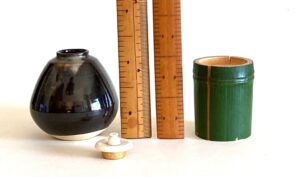
Left: nasu-gata cha-ire, 茄子茶入, eggplant-shape tea-container, ceramic with black/brown glaze, H. 1.8 sun kujira-jaku, with hei-shi buta, 瓶子蓋, bottle-of lid, ivory with gilt interior. Center: mono-sashi, 物差, thing-difference, kujira-jaku, 鯨尺, whale-span, and kane-jaku, 曲尺, bend-span. Right: ao-dake moto-bushi futa-oki, 青竹元節蓋置, green-bamboo origin-node lid-place, H. 1.8 sun kane-jaku – used with fu-ro, 風炉, wind-hearth.
Note the height of the narrow shoulder of the chaire is four-fifths the height of the chaire, just as the lowest level of the bamboo fushi is four-fifths the height of the futaoki. The ratio between the heights of the futaoki and the chaire is 8:10. Again, the number 18.
The relationship of eight and ten with regards to the futaoki may have its roots in Buddhism. The arts and crafts employed to create various visual representations of many deities are highly formulative. A familiar image of the Buddha is based primarily on the relationship between eight and ten units of measurement.
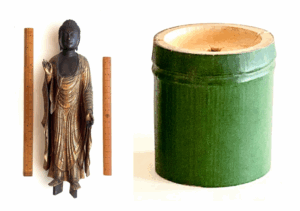
A-mi-da Nyo-rai, 阿弥陀如来, Praise-increase-steep Like-become, wood sculpture. Ao-dake hiki-kiri futa-oki, 青竹引切蓋置, green-bamboo saw-cut lid-place, moto-bushi, 元節, origin-node. Used with the furo.
The full height of the Amida figure is one shaku kujira-jaku, approximately 377 cm. The height from the bottom to the three neck rings is one shaku kane-jaku. In Buddhism, enlightened beings have three rings around their neck called San-dō, 三道, Three-ways.
In Hinduism, Lord Shiva is often depicted with a snake coiled three times around his neck, symbolizing the past, present, and future, and representing Shiva’s mastery over time. The snake, identified as Vasuki, is also a representation of Kundalini energy, which is a spiritual power that can be awakened within a person. Shiva’s association with the snake also signifies his control over fear, death, and the natural world.
The three rings or folds on the neck symbolize the three trainings in Buddhism: Sila, Samadhi, Prajñā:
- Sila: 戒 (kai) – discipline, ethics, morality, or ethical conduct
- Samadhi: 三昧 (san-mai) – concentration, meditative absorption, or mindfulness.
- Prajñā: 智慧 (chie) or 般若 (han-nya) – insight, wisdom, or transcendent wisdom.
Another interpretation of the three rings is that they are the three stages leading to enlightenment: Seeing, Practicing, and Not Learning (Knowing).
Sandō, three ways, is also written, san-dō, 参道, three-ways, that implies a visit to a shrine or temple.
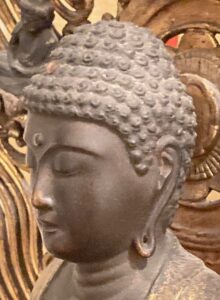
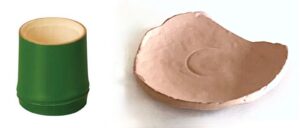
Left: Ao-dake gui-nomi, 青竹ぐい呑, green-bamboo gulp-drink. Right: Su-yaki hira-hai, 素焼き平盃, plain-fired flat-cup, I-se Jin-gū, 伊勢神宮, That-strength God-palace.(Purposefully broken after offering),
Bamboo as a natural vessel, has been used a container of water, sake, and other liquids. Sakazuki made of ao-dake, 青竹, green-bamboo, is an age-old custom. Such cups are commercially available especially for summer enjoyment. The standard size of the sakazuki is 4.8 x 5.2cm, or 1.5 x 1.8 sun kane-jaku.
Sake is drunk for simple enjoyment accompanying food, and perhaps more importantly at religious ceremonies. This is especially true in Shintō where at shrines sake is sanctified and becomes o-mi-ki, お神酒, hon.-god-alcohol. Part of sacred rites includes drinking omiki from shallow saucers called hira-hai, 平盃, flat-saucer. A hirahai is the origin of the mae-kawarake, 前土器, fore-earth-container, the round tile that is placed in the furo to divert the heat of the fire to kama to boil water. The Ise hirahai suyaki, 素焼き, plain-fired; has a diameter of 3 sun kane-jaku. The pottery hirahai diameter is twice the diameter of the green bamboo guinomi.
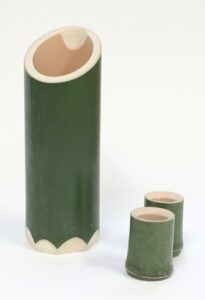
Ao-dake to-kkuri, 青竹徳利, green-bamboo virtue-advantage, sake-bottle, and two gui-nomi, ぐい呑, gulp-drink, cups.
The ao-dake to-kkuri, 青竹徳利, green-bamboo virtue-advantage, sake-bottle, with two fushi, 節, nodes, and slanted cut with notch for ease of pouring; h. 250 – 350cm, approximately 300cm, or one shaku kane-jaku. With bamboo plug stopper. The vessel’s bamboo growth direction is upward as in nature.
Two gui-nomi, ぐい呑, gulp-drink, cups; h. 1.8 sun kane-jaku. The bamboo growth direction is upward. These are intended as fū-u, me-oto, 夫婦, husband-wife, set of two cups with one larger than the other, symbolizing wedded happiness.
According to tradition, only one tokkuri and two guinomi can be cut from a single stalk of bamboo. This is due to the size and space between the fushi.
Aodake sakazuki, 青竹盃, a green bamboo sake cup for celebrations and special occasions, praying for development and growth like bamboo, reaches toward the sake, has refreshing smell, and imparts a pleasing taste to the sake.
Green bamboo is prevalent in celebratory use and also display. After a celebration in which the green bamboo sake bottle and cups were used, the bottle could become a hana-ire, 花入, flower-receptacle, a cup could be used as a futaoki.
Musubi yanagi, 結柳, tied willow, held in an ao-dake hana-ire, 青竹花入, green-bamboo flower-receptacle, hung on a yanagi-kugi, 柳釘, willow hook.
Part of the decorations for the New Year, is a long-trailing willow branch tied together with a branch, and put into a green bamboo tube. It is ideally displayed in the tokonoma on a yanagi kugi, 柳釘, willow-hook, in the back left corner near the ceiling.
The length of the bamboo is one kane-jaku, with a hole cut near the top opening. Water is not put into the bamboo. According to Hōunsai XV, the container should not have water in it. Willows root easily, and the New Year’s willow is for the moment and put in a river after the holidays.
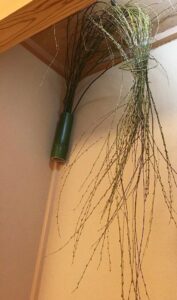
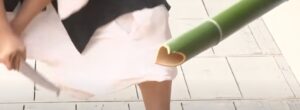
One of Japan’s oldest rites is Take-kiri-e-shiki, 竹伐り会式, Bamboo-cut-ceremony-rite, which takes place on June 20 at Kura-ma–dera, 鞍馬寺, Saddle-horse-temple, in the mountains northeast of Kyōto. Warrior monks with traditional swords, cut through stalks of green bamboo that measure 4 meters long. A diagonal cut of the bamboo shows that it was cut with a single strike of the blade, and therefore is indicative of good luck and fortune.
Green bamboo will be featured in the festival of 7th night of the 7th moon, Tanabata, 七夕, Seven-night, on August 28, when departed spirits are welcomed back to the family home, which culminates on O-bon, お盆, Hon.-tray, September 6th. Stalks of green bamboo have ornaments and paper prayers attached, in a rite of purification.
The bamboo stalk represents a great snake, Dai-ja, 大蛇, Large-snake. The rite originated in a story from the Heian period when a monk Bu-en Sho-nin, 峯延上人, Peak-prolong Upper-person, killed a great snake that attacked him during his training in the forest later the site of Kurama-dera. The prayers of the monk brought the aid of Bi-sha-mon-ten, 毘沙門天, Assist-sand-gate-heaven (Deva), and with a lightning bolt, a great tree fell and killed the snake. Bishamonten, in the North, is the Buddhist guardian of Kyōto.
Sōtan treasured a bamboo futaoki made by his grandfather, Rikyū. Sōtan avoided aristocratic tutelage that contributed to the problems incurred from the nobility. However, a lord greatly admired the futaoki, and Sōtan gave it to him. In return, the lord, as recompense, gave Sōtan a sum of money that was used to construct the Yū-in, 又隠, Again-retire, a Teahut that Sōtan dedicated to Rikyū.
For further study, see also: Futaoki and Futaoki and the Number Five

